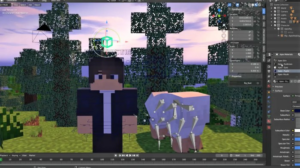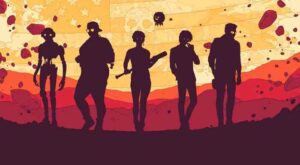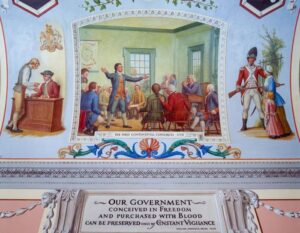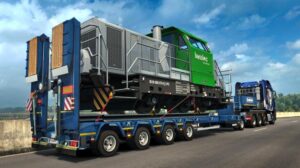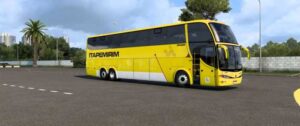Miscellaneous 3D Minecraft Content opens up a whole new dimension of creativity and gameplay possibilities, allowing players to go beyond the standard blocks and items and build truly unique and immersive worlds. From custom furniture and vehicles to intricate structures and fantastical creatures, the possibilities are endless.
This guide will delve into the exciting world of creating and using custom 3D models in Minecraft, exploring the tools, techniques, and communities that make this form of content creation possible. We’ll examine the diverse applications of custom objects, from enhancing gameplay and storytelling to building truly breathtaking worlds.
Types of Miscellaneous 3D Minecraft Content
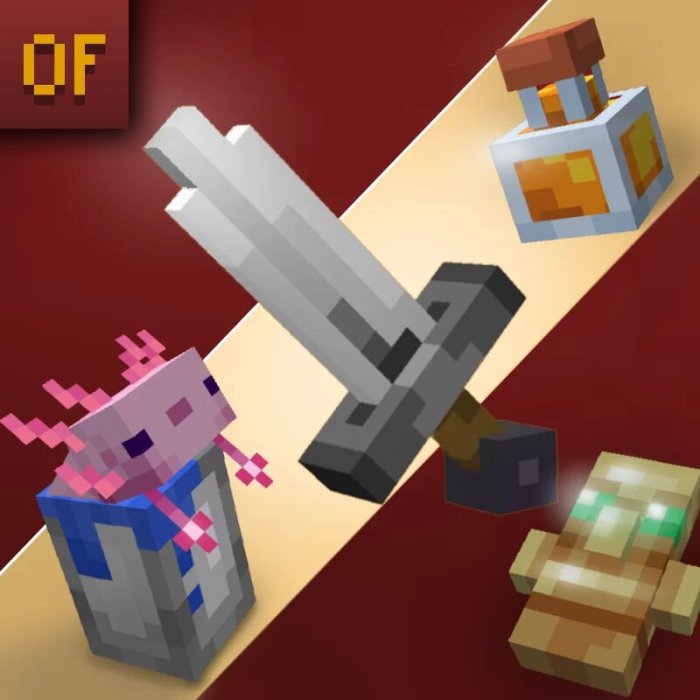
Minecraft’s 3D world extends beyond standard blocks and items, encompassing a diverse range of content that enriches the gameplay experience. These miscellaneous elements add depth and variety, offering players unique opportunities for creativity and exploration.
3D Models
D models are essential for creating custom objects, structures, and characters in Minecraft. They allow players to go beyond the limitations of the standard block palette, enabling them to build intricate designs and bring their imaginations to life.
- Custom Mobs: Players can create unique creatures with distinct behaviors and abilities, expanding the game’s ecosystem.
- Furniture and Decorations: 3D models allow players to furnish their builds with realistic and detailed objects, adding a touch of realism and personality.
- Vehicles: Cars, boats, and even flying machines can be created using 3D models, adding new dimensions to transportation and exploration.
Animations
Animations bring life and dynamism to 3D Minecraft content, adding a layer of interactivity and visual appeal. They can be used to create dynamic effects, realistic movements, and engaging stories.
From intricate pixel art to awe-inspiring builds, the Minecraft community is bursting with creativity. But what if you want to take your creations to the next level? Exploring Minecraft 1.19 3D: What’s New? Exploring Minecraft 1.19 3D: What’s New?
will give you an idea of what’s possible. This update has opened up a whole new world of possibilities for 3D content, allowing you to showcase your builds and designs in a whole new light. So, whether you’re a seasoned builder or just starting out, be sure to check out the latest 3D features and see what you can create!
- Character Animations: Players can animate their custom mobs or characters to walk, run, jump, and interact with their surroundings, enhancing their realism and personality.
- Object Animations: Animations can be applied to objects like doors, levers, and machines, creating realistic interactions and bringing them to life.
- Environmental Effects: Animations can be used to create special effects like fire, water, and explosions, enhancing the visual appeal and immersion of the game world.
Textures
Textures are the visual representations of 3D models, determining their appearance and adding detail. They play a crucial role in creating realistic and aesthetically pleasing content.
- Custom Block Textures: Players can create unique textures for blocks, expanding the game’s visual palette and allowing for personalized builds.
- Mob Textures: Customized textures can give mobs a unique appearance, making them more visually appealing and distinctive.
- Environment Textures: Players can create textures for terrain, water, and other environmental elements, adding realism and visual depth to the game world.
Sounds
Sounds play a vital role in enhancing the immersive experience of Minecraft, adding realism and atmosphere to the game world. Custom sounds can bring 3D content to life, making it more engaging and interactive.
- Custom Mob Sounds: Unique sounds for mobs can add to their personality and make them more distinctive.
- Environmental Sounds: Custom sounds for rain, wind, and other environmental elements can create a more immersive and realistic atmosphere.
- Object Sounds: Sounds for objects like doors, levers, and machines can add to their realism and interactivity.
Scripts
Scripts allow for the creation of custom behaviors and interactions within Minecraft, adding a layer of complexity and dynamism to 3D content.
- Custom Mob AI: Scripts can be used to create complex AI for mobs, making them more intelligent and engaging.
- Interactive Objects: Scripts can be used to create objects that respond to player interactions, adding a layer of interactivity to the game world.
- Game Mechanics: Scripts can be used to create new game mechanics, adding depth and variety to the gameplay experience.
Data Packs
Data packs allow for the creation of custom game rules, functions, and advancements, adding a layer of customization and complexity to Minecraft.
- Custom Game Modes: Data packs can be used to create new game modes with unique rules and mechanics.
- Gameplay Tweaks: Data packs can be used to modify existing game mechanics, adding new challenges or making the game easier.
- Custom Achievements: Data packs can be used to create custom achievements, providing players with new goals to strive for.
Shaders, Miscellaneous 3D Minecraft Content
Shaders enhance the visual fidelity of Minecraft, adding realistic lighting, shadows, and effects that improve the overall aesthetic appeal.
- Realistic Lighting: Shaders can create more realistic lighting effects, adding depth and dimension to the game world.
- Improved Shadows: Shaders can create more detailed and realistic shadows, enhancing the visual impact of objects and structures.
- Special Effects: Shaders can add special effects like bloom, depth of field, and motion blur, enhancing the visual immersion of the game world.
Resource Packs
Resource packs allow for the customization of the game’s textures, sounds, and other assets, providing players with a wide range of options for personalization.
- Custom Textures: Resource packs can be used to replace the default textures of blocks, mobs, and other objects with custom designs.
- Custom Sounds: Resource packs can be used to replace the default sounds of the game with custom sound effects.
- Custom Music: Resource packs can be used to replace the default music of the game with custom soundtracks.
Table of Miscellaneous 3D Minecraft Content
| Category | Description | Examples |
|---|---|---|
| 3D Models | Custom objects, structures, and characters that extend beyond the standard block palette. | Custom mobs, furniture, vehicles |
| Animations | Dynamic effects, realistic movements, and engaging stories brought to life through movement. | Character animations, object animations, environmental effects |
| Textures | Visual representations of 3D models, determining their appearance and adding detail. | Custom block textures, mob textures, environment textures |
| Sounds | Enhance the immersive experience by adding realism and atmosphere to the game world. | Custom mob sounds, environmental sounds, object sounds |
| Scripts | Custom behaviors and interactions within Minecraft, adding a layer of complexity and dynamism to 3D content. | Custom mob AI, interactive objects, game mechanics |
| Data Packs | Custom game rules, functions, and advancements, adding a layer of customization and complexity to Minecraft. | Custom game modes, gameplay tweaks, custom achievements |
| Shaders | Enhance the visual fidelity of Minecraft, adding realistic lighting, shadows, and effects that improve the overall aesthetic appeal. | Realistic lighting, improved shadows, special effects |
| Resource Packs | Customization of the game’s textures, sounds, and other assets, providing players with a wide range of options for personalization. | Custom textures, custom sounds, custom music |
Creation and Design Techniques
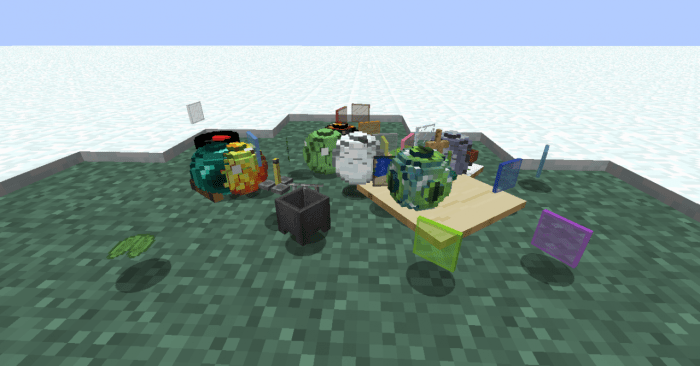
Creating miscellaneous 3D Minecraft content involves a blend of software expertise and artistic vision. This section delves into the tools and techniques used to bring these custom creations to life.
Software and Tools
The software used for creating 3D models for Minecraft can be broadly categorized into two groups: 3D modeling software and texture editing software.
- 3D Modeling Software:These programs allow users to create 3D objects from scratch. Popular choices include:
- Blender:A free and open-source software with a vast range of features, making it suitable for beginners and experienced users alike.
- Maya:A professional-grade software used in film and game industries, known for its advanced animation and rendering capabilities.
- 3ds Max:Another professional-grade software favored for its robust modeling and animation tools.
- Blockbench:A dedicated Minecraft modeling software that simplifies the process of creating block-based models.
- Texture Editing Software:These programs are used to create and edit the textures that give 3D models their visual appearance. Some popular options include:
- GIMP:A free and open-source image editor with a wide range of features.
- Photoshop:A powerful and industry-standard image editing software known for its extensive features.
- Paint.NET:A free and user-friendly image editor suitable for beginners.
Modeling Custom Objects
The process of modeling custom objects in 3D software involves several key steps:
- Conceptualization:Start by sketching or visualizing the object you want to create. This helps define its shape, size, and details.
- Modeling:Use the 3D software’s tools to build the object’s basic shape. Techniques like extrusion, beveling, and subdivision modeling can be employed to achieve the desired form.
- Detailing:Add finer details to the model, such as textures, bumps, and edges, to enhance its realism.
- Optimization:For Minecraft, it’s crucial to optimize the model’s polygon count to ensure smooth performance. This involves simplifying the model’s geometry without sacrificing visual quality.
Texturing Custom Objects
Textures play a vital role in defining the visual appearance of 3D models.
- Texture Creation:Use texture editing software to create or edit images that will be applied to the model’s surfaces. Textures can be created from scratch, using photographs, or by combining different elements.
- Texture Mapping:Map the created textures onto the model’s surfaces. This involves assigning the texture image to specific parts of the model, ensuring that it wraps around the object’s geometry realistically.
- Texture Optimization:Similar to model optimization, it’s important to optimize textures for performance. This might involve reducing the image resolution or using compression techniques.
Importing and Integrating Custom 3D Models
Once the model and textures are ready, they need to be imported and integrated into Minecraft.
- Exporting the Model:Export the model from the 3D software in a format compatible with Minecraft, such as OBJ or FBX. Ensure that the model’s textures are included in the export.
- Using a Model Importer:Use a Minecraft model importer tool, such as Blockbench or the Minecraft Model Importer, to convert the exported model into a format that Minecraft can recognize. These tools often provide options for adjusting the model’s size, rotation, and other properties.
- Placing the Model in Minecraft:Once imported, the model can be placed in Minecraft using various methods. One common approach is to create a resource pack that includes the model and its textures. This resource pack can then be loaded in Minecraft, making the custom model available for use in the game.
Applications and Uses
Miscellaneous 3D Minecraft content finds its place in a wide array of applications within the game, enriching gameplay, storytelling, and world-building in unique ways. From enhancing existing structures to creating entirely new environments, custom objects open up a world of possibilities for players seeking to personalize their Minecraft experiences.
Enhancing Gameplay
Custom objects can significantly enhance gameplay mechanics, adding depth and complexity to the Minecraft experience.
- Functional Objects:These objects can serve practical purposes, such as custom crafting stations, advanced storage systems, or automated farms, streamlining resource management and gameplay efficiency.
- Interactive Elements:Interactive elements, such as custom levers, buttons, or pressure plates, can be integrated into complex mechanisms, creating intricate puzzles or automated systems that add a layer of challenge and engagement.
- Gameplay Modifiers:Custom objects can modify existing gameplay mechanics, introducing new challenges or altering existing ones. For instance, custom blocks that affect gravity or light levels can introduce unique gameplay experiences.
Storytelling and World-Building
Custom objects play a crucial role in crafting immersive narratives and building detailed worlds.
- Environmental Storytelling:Custom objects can be used to create atmospheric environments that convey a specific narrative or mood. For example, weathered signs with cryptic messages or ancient statues with intricate carvings can hint at a forgotten civilization or a mysterious past.
- Character Development:Custom objects can be used to represent characters, their possessions, or their stories. For instance, a player could create a custom armor set with unique designs to represent their character’s identity or create a custom sword with a specific inscription to tell a story about a legendary hero.
- World Expansion:Custom objects can be used to expand the world’s boundaries, creating new landscapes, structures, or even entire biomes. Players can create unique landscapes with custom flora and fauna, or construct elaborate structures that defy the limitations of standard Minecraft blocks.
Potential Uses
Here’s a list of potential uses for custom content, categorized by their impact on gameplay:
| Impact | Examples |
|---|---|
| Gameplay Enhancement | Custom crafting recipes, automated systems, resource management tools |
| Storytelling and World-Building | Unique landscapes, character representations, atmospheric environments |
| Community Building | Shared custom objects, resource packs, collaborative projects |
| Educational Purposes | Visual aids for teaching concepts, interactive learning experiences |
Community Resources and Collaboration
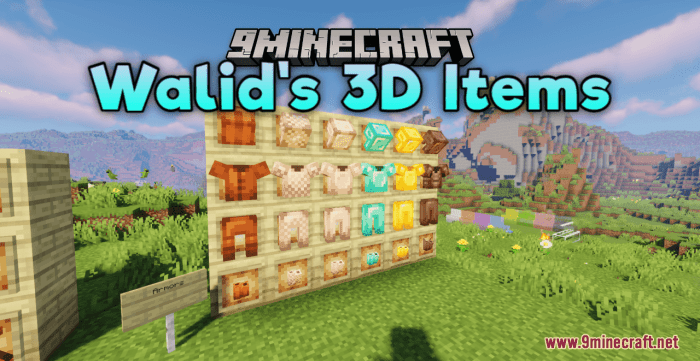
The Minecraft community is a vibrant ecosystem of creators and players who share a passion for the game and its endless possibilities. This community plays a vital role in the development and distribution of miscellaneous 3D Minecraft content, fostering a collaborative environment where ideas are shared, projects are supported, and creativity flourishes.The online landscape provides numerous platforms and websites dedicated to the creation and distribution of custom content for Minecraft.
These platforms act as central hubs where creators can showcase their work, connect with other enthusiasts, and access a vast library of resources.
Popular Platforms and Websites
These platforms serve as online marketplaces where creators can share their work, find inspiration, and collaborate with others.
- Planet Minecraft:This website is a popular destination for Minecraft players and creators to share their creations, from maps and mods to skins and texture packs. It features a user-friendly interface, allowing users to browse, download, and rate content.
- CurseForge:This platform is primarily focused on Minecraft mods and add-ons, offering a comprehensive library of community-created content. Creators can upload their projects, manage versions, and engage with users through forums and discussions.
- Minecraft Marketplace:This official platform allows creators to sell their creations directly to Minecraft players. This platform offers a curated selection of high-quality content, including maps, skins, and texture packs.
- Reddit (r/Minecraft):This subreddit serves as a central hub for discussions, news, and community projects related to Minecraft. It provides a platform for creators to share their work, seek feedback, and collaborate with others.
Benefits of Collaboration
Collaboration among creators in the Minecraft community offers several advantages:
- Shared Expertise:Collaborating with others allows creators to tap into a diverse range of skills and perspectives, leading to more comprehensive and innovative projects.
- Increased Reach:By working together, creators can expand their audience and reach a wider range of players.
- Faster Development:Collaborative efforts can accelerate the development process, allowing creators to complete projects more efficiently.
- Enhanced Quality:Feedback and constructive criticism from fellow creators can improve the quality and polish of projects.
Challenges of Collaboration
While collaboration offers numerous benefits, it also presents challenges:
- Communication:Effective communication is crucial for successful collaboration. Misunderstandings and conflicting visions can hinder progress.
- Time Management:Coordinating schedules and workloads can be challenging, especially when working with creators from different time zones.
- Creative Differences:Collaborating with others can lead to disagreements and creative differences, which require open communication and compromise.
- Ownership and Credit:Establishing clear ownership and crediting guidelines is essential to avoid disputes and ensure fair recognition for everyone’s contributions.
Creative Inspiration and Design Trends: Miscellaneous 3D Minecraft Content
The realm of miscellaneous 3D Minecraft content is constantly evolving, driven by the creativity and ingenuity of its community. This dynamic environment fosters a diverse range of design trends, inspired by various sources and driven by the desire to push the boundaries of what’s possible within the game’s virtual world.
Popular Styles and Trends
The diverse styles within miscellaneous 3D Minecraft content reflect the varied interests and aesthetics of its creators. Here are some popular trends that have gained significant traction within the community:
- Realistic and Detailed Designs:Many creators strive to achieve a level of realism in their creations, replicating real-world objects and structures with remarkable accuracy. This trend is fueled by advancements in texture packs and the increasing availability of high-resolution assets. For example, recreations of iconic landmarks like the Eiffel Tower or the Taj Mahal demonstrate the impressive level of detail and realism that can be achieved within Minecraft’s 3D environment.
These creations not only showcase the technical prowess of the creators but also highlight the versatility of the game’s building blocks.
- Abstract and Minimalist Designs:In contrast to realistic representations, some creators embrace abstract and minimalist styles, focusing on geometric shapes, clean lines, and a limited color palette. This approach often emphasizes the inherent beauty of simplicity and allows for creative exploration within a restricted framework.
Examples include intricate geometric patterns, floating structures with minimal detailing, and landscapes composed of contrasting colors and textures. These creations often evoke a sense of serenity and tranquility, showcasing the potential for abstract expression within the Minecraft environment.
- Fantasy and Sci-Fi Themes:The limitless possibilities of Minecraft’s world-building tools have inspired many creators to explore fantasy and sci-fi themes. From towering castles and enchanted forests to futuristic cities and alien landscapes, these creations often feature unique and imaginative designs, drawing inspiration from popular media and literary works.
These creations often incorporate custom textures, models, and shaders to create immersive and fantastical experiences, showcasing the potential for storytelling and world-building within the game.
Innovative Uses of Custom Objects
The creation and use of custom objects have significantly expanded the creative possibilities within miscellaneous 3D Minecraft content. Here are some examples of innovative uses of these objects in gameplay and world design:
- Functional Gameplay Elements:Custom objects can be integrated into gameplay mechanics, adding new dimensions to player interaction and challenge. For example, creators have developed custom blocks with unique properties, such as a block that explodes upon activation or a block that acts as a teleportation point.
These objects can be used to create custom minigames, puzzles, and even entirely new gameplay experiences, pushing the boundaries of traditional Minecraft gameplay.
- Enhanced Storytelling and Worldbuilding:Custom objects can be used to enrich the narrative and atmosphere of a Minecraft world. For example, creators have developed custom models of characters, creatures, and objects that contribute to the lore and backstory of their creations. These objects can be used to create immersive environments that tell stories through visual cues and interactive elements, enhancing the overall experience for players.
- Unique Visual and Aesthetic Effects:Custom objects can be used to achieve unique visual effects and enhance the aesthetic appeal of Minecraft worlds. For example, creators have developed custom shaders that create realistic lighting effects, dynamic weather patterns, and immersive atmospheric conditions. These objects can be used to create visually stunning worlds that captivate players and leave a lasting impression.
Inspirational Resources and Techniques
Aspiring creators can draw inspiration from various resources and techniques to develop their own unique styles within miscellaneous 3D Minecraft content. Here are some key sources of inspiration and practical tips:
- Online Communities and Forums:Online communities and forums dedicated to Minecraft content creation provide a platform for sharing ideas, seeking feedback, and discovering new trends. Engaging with other creators, exploring their projects, and participating in discussions can offer valuable insights and spark creative inspiration.
These platforms often feature tutorials, resource packs, and custom models, providing aspiring creators with practical tools and resources.
- Tutorials and Educational Resources:Numerous online tutorials and educational resources are available, covering various aspects of 3D Minecraft content creation, from basic modeling and texturing to advanced scripting and shader development. These resources can provide a structured learning path for aspiring creators, equipping them with the necessary skills and knowledge to bring their ideas to life.
Many creators also share their own experiences and tips through video tutorials and blog posts, offering practical advice and guidance.
- Experimentation and Iteration:The best way to develop a unique style is to experiment with different techniques, tools, and concepts. Don’t be afraid to try new things, explore different design approaches, and iterate on your creations. Embrace the iterative process of creation, learning from your mistakes and refining your skills with each new project.
Summary
The world of miscellaneous 3D Minecraft content is a vibrant and ever-evolving landscape. With a little creativity and the right tools, anyone can contribute to this exciting community and bring their own unique visions to life within the Minecraft universe.
Whether you’re a seasoned builder or just starting out, exploring the possibilities of custom 3D models is sure to unlock a whole new level of creativity and enjoyment in Minecraft.
